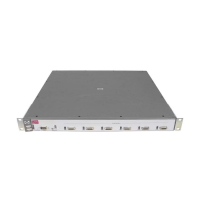IP Routing Features
Configuring IP Parameters for Routing Switches
Configuring IP Parameters for Routing
Switches
The following sections describe how to configure IP parameters. Some param-
eters can be configured globally while others can be configured on individual
VLAN interfaces. Some parameters can be configured globally and overridden
for individual VLAN interfaces.
Note This section describes how to configure IP parameters for routing switches.
For IP configuration information when routing is not enabled, see chapter 7,
“Configuring IP Addressing”.
Configuring IP Addresses
You can configure IP addresses on the routing switch’s VLAN interfaces.
Configuring IP addresses is described in detail in the chapter titled “Config-
uring IP Addressing” in the Management and Configuration Guide for your
switch.
Changing the Router ID
In most configurations, a routing switch has multiple IP addresses, usually
configured on different VLAN interfaces. As a result, a routing switch’s identity
to other devices varies depending on the interface to which the other device
is attached. Some routing protocols, including Open Shortest Path First
(OSPF), identify a routing switch by just one of the IP addresses configured
on the routing switch, regardless of the interfaces that connect the routing
switches. This IP address is the router ID.
Note Routing Information Protocol (RIP) does not use the router ID.
By default, the router ID on an HP routing switch is the lowest numbered IP
interface configured on the device.
If you prefer, you can explicitly set the router ID to any valid IP address. The
IP address cannot be in use on another device in the network.
Note To display the router ID, enter the show ip ospf CLI command at any Manager
EXEC CLI level.
11-10

